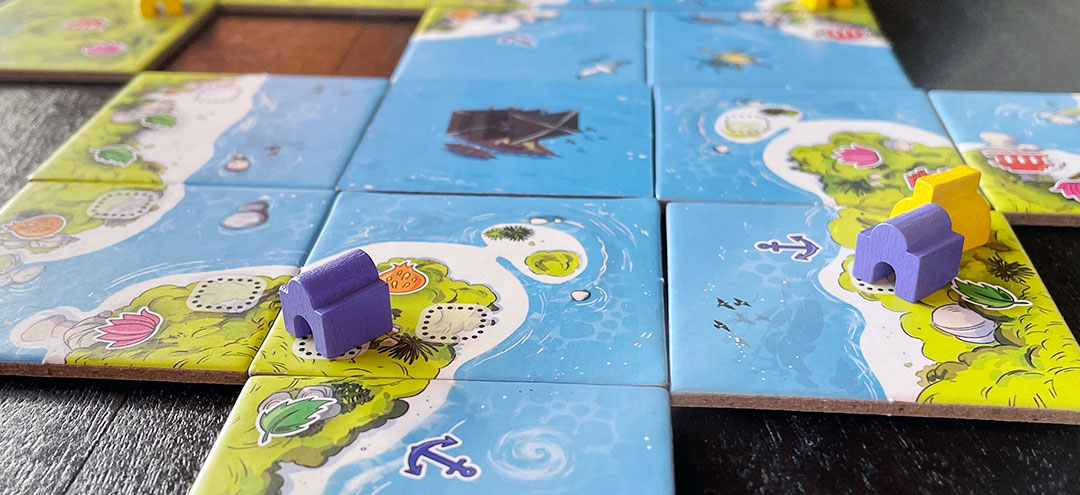 It wasn’t until I had Small Islands setup that I realized I’d become the most recent Board Game Quest connoisseur of ships and open water. From Sleeping Gods to Anno 1800 to Tranquility, I was once again navigating oceanic cardboard to bring a sweet and salty perspective to this recurrent tabletop theme. As I stepped aboard my vessel—ready to set sail, adventure on the horizon, and my captain’s hat tilted to one side—I wondered into the wind, was my true calling as a master strategy sailor finally close at hand?
It wasn’t until I had Small Islands setup that I realized I’d become the most recent Board Game Quest connoisseur of ships and open water. From Sleeping Gods to Anno 1800 to Tranquility, I was once again navigating oceanic cardboard to bring a sweet and salty perspective to this recurrent tabletop theme. As I stepped aboard my vessel—ready to set sail, adventure on the horizon, and my captain’s hat tilted to one side—I wondered into the wind, was my true calling as a master strategy sailor finally close at hand?
Small Islands is a tile placement and hidden objective game for one to four players. Designed by Alexis Allard, illustrated by Aurélie Guarino, and supplied by Lucky Duck Games, it plays in approximately thirty minutes for ages eight and older. Sound interesting? Then let’s hoist the sails, raise the anchor, and glide beyond the break toward yet another undiscovered archipelago.
Gameplay Overview:
Over a maximum of four rounds, players select a tile to place into a central tableau to build upon existing islands or create new ones. The goal is to create islands that match the mission on a personal hidden objective, which scores at the end of a round. Players may only claim points from islands that meet current objective requirements.
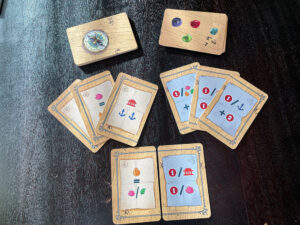
Before we leave the dock, let’s look a little deeper at how each round is setup. Players begin each game with two landscape tiles, four bonus tokens, and four houses. They then must choose a current objective and cache another for possible use the next round. The first player also places four starting tiles into the central tableau and creates a navigation stack of six tiles that fill into the “market” and dictate round length.
Turns consist of players exploring, by selecting a landscape tile from three face-up options, and then choosing one of their three tiles to place onto the table following placement rules. Placement requires lands and/or waters to match, and the tiles can be rotated to maximum effect. Each landscape tile features a mix of land and water, though a few tiles do feature only land and can be harder to place. Tiles also feature one or more of five unique icons (flower, fruit, leaf, temple, or port) that correspond to player’s hidden objectives.
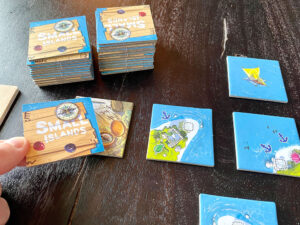
Once the navigation stack of six tiles is depleted, players have the option to land a ship by placing one of the four available ship tiles and thus ending the round. In a two-player game, there are two ships matching player colors and two gray ships, whereas in a four-player game each ship matches a player color. Players may only place their own color ship or a gray ship (if available). Otherwise, they must wait until another player lands a ship and triggers the reward phase.
In the reward phase, players reveal hidden objectives. Then, starting with the player who landed a ship, each take turns placing a house onto an available island that matches an objective they wish to score. As there are four houses available per round, and islands can only be scored once, players may opt to not place a house.
After the reward phase is complete and players have gained their points, a new navigation stack of six tiles is created, new objective cards are dealt, and play continues. The game ends when either all ships have landed, or the reserve stack of landscape tiles have been placed. Beyond points gained by placing houses, players also score for any port icons located around their ship at game end.
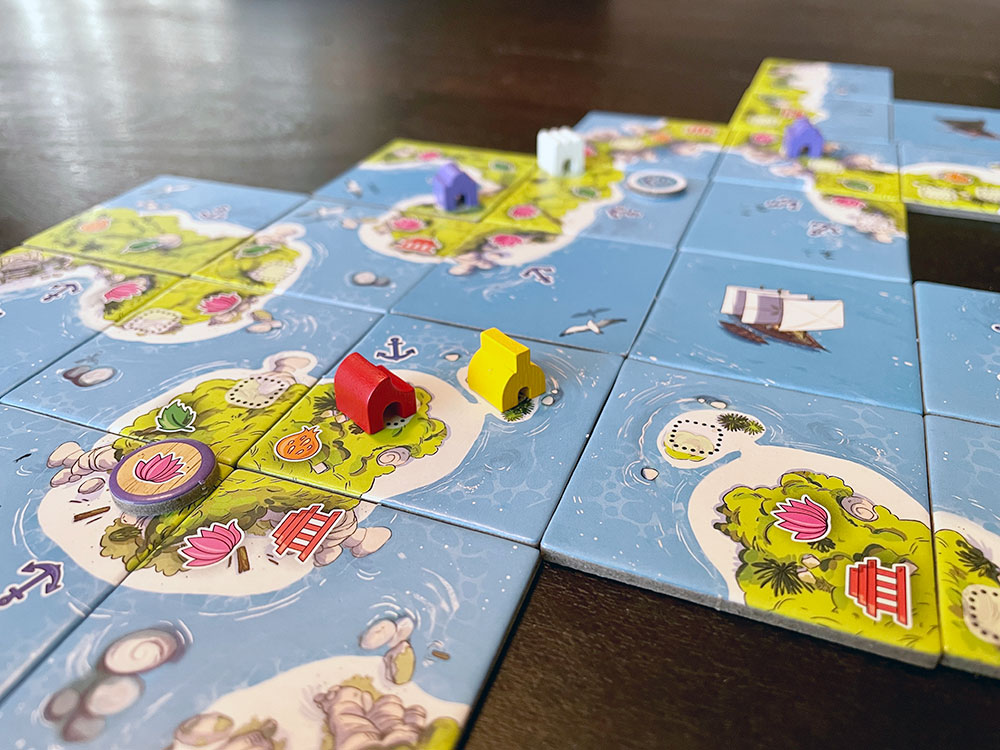
Game Experience:
For a lighter tile placement game, Small Islands has a lot to cover in its rules. That said, everything coalesces after a single game, and it plays incredibly fast even at the four-player count. If you do have players that tend toward analysis paralysis, it may increase playtime, though not significantly. Once objectives are chosen, each player has a distinctive goal of creating as many islands as possible that feature their scoring icons or boosting a single island with said icons to maximize points.
There’s very little downtime as players select a tile, choose one to place, then wait for their next turn. Since there are only six tiles in the navigation stack, a round may end quickly if a player wants to stop others from scoring too many points, but the hidden objective cards and the luck of the draw can make it hard to completely distinguish which objectives other players are hoping to achieve. As such, you may find that a tile you’ve placed has not only helped you, but also helped others as well.
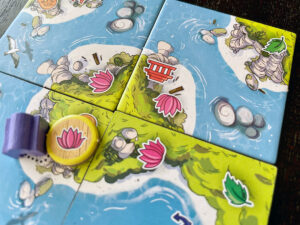
Some of the luck is mitigated by allowing players to cache an objective for the next round. By doing this, players can be thinking about not only the current round, but also future scoring opportunities. In the normal mode, objective cards feature both their mission goal and reward, but once players become more comfortable with scoring, switching to the advanced mode gives players more flexibility with objectives. It’s a welcomed addition to a lighter game, but it does require more analysis and thus can create more downtime between rounds.
Another bit of mitigation added to assist with luck are the four bonus tokens. These tokens feature several of the landscape icons and can be added to a tile during a turn to boost scoring chances. They are one-time use and remain in play so they may hinder or assist other players as well. While they may not seem like a significant feature, they do allow players to push for icon majorities or add much needed ports for extra points.
Strategy only goes so far in a game where you can’t find the right tile or a round ends early due to another player landing their ship. As such, there are frustrating times where it feels like the amount of energy you put into your objectives provides diminishing returns. This may be due to how fast the navigation stack depletes, which doesn’t scale by player count, and creates an end of round trigger that provides tension but also restricts gameplay and enhances the luck factor.
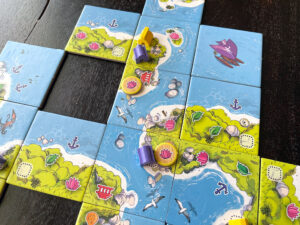
Speaking of luck, one of the objectives relates to discovery tokens. These grant players four to seven points per token and are obtained via objective cards. While scoring is relatively tight in many games I’ve played, the discovery token objective was typically easy to complete multiple times and always provided great return on investment. Its inclusion felt tacked on to provide a different style of scoring and while linked to the temple icon, thematically they didn’t connect for us.
The solo module is a welcomed addition. The automa features a deck of cards seeded to match the chosen difficulty. Each difficulty provides a different style of play. For example, at level four, the solo deck’s focus is to land ships, meaning the automa tries to end the round as soon as the navigation stack is depleted. This leaves players with less time to develop islands for points. The automa bases their tile placement off the last tile you’ve played so there is a little strategy to consider on every turn to minimize their port scoring.
Final Thoughts:
I’ve had fun with Small Islands. I expected it to play like Carcassonne out of the box, but once I realized it featured hidden objectives and interactivity based on how long each round lasts, it began to carve a niche all its own. It’s played well at all counts, including the solo mode which has proven to be a fun (and downright difficult) challenge. The fact that each play has featured tight scoring continues to provide incentive to try new approaches. It does have moments of frustration though, especially when the fast gameplay brushes up against the small window of strategic planning. Beyond gameplay, the landscape tile artwork is lush and looks great on the table. Small Islands does take up quite a bit of room as the tableau expands, but with an evolving tile placement title you must expect this space requirement. It also features both normal and advanced mode achievements on the back of the rulebook as well as some hidden treasures to discover if you complete at least five from each list.
Final Score: 3.5 stars – A swift journey through uncharted terrain that provides variability to combat its lack of strategic depth.
 Hits:
Hits:
• Snappy playtime
• Advance mode objectives
• Challenging solo experience
Misses:
• Limits on strategy
• Navigation stack trigger
• Discovery token scoring







